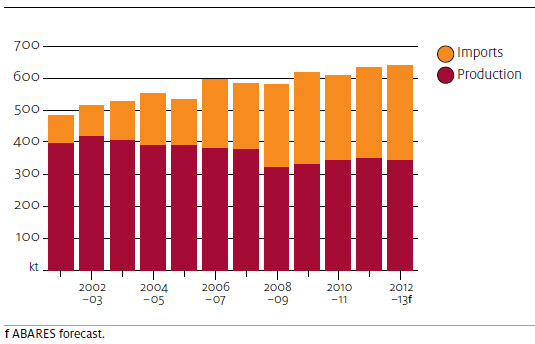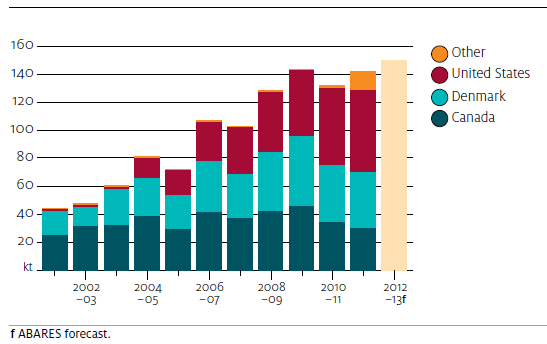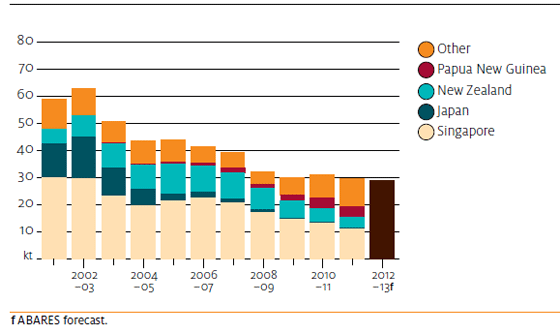



Agricultural Commodities: Pig Meat
A review of the state of the industry by Clay Mifsud, based on research by the Australian Bureau of Agricultural and Resource Economics and Sciences (ABARES) for the September Quarter 2012.A number of recent developments are expected to affect the financial performance of Australia’s pig meat industry in 2012–13. First, the price of domestic feed grains, which accounts for more than 50 per cent of production costs, are forecast to rise, largely reflecting higher world prices due to production shortfalls in the United States and the Black Sea region. Second, the value of the Australian dollar is assumed to remain high, which has the potential to adversely affect pig meat exports.
Australian Pig Meat Production and Imports

Production to Decline in 2012–13
In 2012–13, Australian pig meat production is forecast to fall by 2 per cent to 345 000 tonnes. The forecast fall in production reflects an assumed decline in breeding sow numbers over the coming year, as producers adjust to higher feed grain prices and competition from imports in the processed pig meat market. During the first two months of 2012–13, the pig-to-wheat and pig-to-barley price ratios were 18 and 13 per cent lower, respectively, compared with the same period last year. In 2012–13, the Australian weighted average over-the-hooks price of pigs is forecast to decline by 2 per cent to 275 cents a kilogram (dressed weight).
Imports to Rise
Over the 10 years to 2011–12 pig meat imports trebled, resulting in increased competition for domestically produced pig meat in ham, bacon and smallgoods manufacturing. Quarantine restrictions mean that imported pig meat does not compete directly with Australian grown product in the fresh meat market.
Australian Pig Meat Imports

In 2011–12, Australian pig meat imports increased by 8 per cent year-on-year to 142 000 tonnes (shipped weight). Around 90 per cent of imports originated from the United States, Denmark and Canada, three of the world’s largest pig meat exporters. The import unit price of Danish and US pig meat declined by 4 per cent and 5 per cent, respectively, in 2011–12, making it more competitive against Australian pig meat in the processed pig meat market. The share of imports in Australian pig meat consumption rose by 1 percentage point to 48 per cent in 2011–12. Pig meat imports are forecast to increase 7 per cent to 152 000 tonnes (shipped weight) in 2012–13.
Exports Continue to Decline
In 2011–12, pig meat exports fell 5 per cent year-on-year to around 29 000 tonnes
(shipped weight). Shipments to Singapore and New Zealand, which accounted for
half of total pig meat exports, fell 16 and 22 per cent, respectively. Relatively high
Australian pig meat prices in overseas markets, compared with prices from other pig
meat exporters, led to a weakening in competitiveness of Australian pig meat exports.
Australian pig meat exports in 2012–13 are forecast to fall by 3 per cent to around
28 000 tonnes (shipped weight). Australian pig meat prices are expected to remain
comparatively higher in overseas markets than prices of pig meat from the United
States, Canada and Denmark.
Australian Pig Meat Exports

| Outlook for Pig Meat | |||||
|---|---|---|---|---|---|
| unit | 2010-11 | 2011-12 | 2012-13 f | % change | |
| Over the hooks price a | Ac/kg | 269 | 281 | 275 | – 2.1 |
| Slaughterings | ’000 | 4643 | 4733 | 4675 | – 1.2 |
| Production | kt | 342 | 351 | 345 | – 1.6 |
| Import volume b | kt | 132 | 142 | 152 | 7.0 |
| Export volume bc | kt | 31 | 29 | 28 | – 3.4 |
| Export value | $m | 106 | 100 | 96 | – 4.4 |
| a Dressed weight. b Shipped weight. c Excludes preserved pig meat. f ABARES forecast. Sources: ABARES; Australian Bureau of Statistics |
|||||
Further ReadingYou can view the full report by clicking here. |
September 2012








